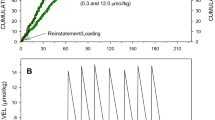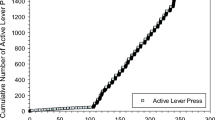Abstract
The breakpoint (BP) of the progressive ratio (PR) schedule of drug delivery is a commonly used estimate of the drug abuse liability and is interpreted as a measure of motivation to get the next dose. This study investigated BP as a product of the rate of response and the duration of lever-pressing activity. The results were not consistent with the conventional interpretation. Rats were trained to self-administer cocaine intravenously under the fixed ratio (FR1) and PR schedules of delivery. The rate of lever presses and the duration of activity before the last self-injection of different cocaine unit doses and before the last press under the PR schedule were analyzed. The rate of presses was independent of the cocaine unit dose and the duration of activity was proportional to the dose. We assume that BP is a measure of the drug’s overall ability to maintain self-administration under the PR schedule. Therefore, the proportionality between the dose and BP is not evidence of a stronger reinforcing effect of higher doses but the result of cocaine level staying longer within the range of cocaine concentrations (the compulsion zone) capable of inducing lever presses. The relationship between the cocaine unit dose and BP does not represent the dose magnitude of the effect function but the dose duration of the effect function.



Similar content being viewed by others
Data availability
Data will be made available on reasonable request.
References
Ahmed SH, Koob GF (1999) Long-lasting increase in the set point for cocaine self-administration after escalation in rats. Psychopharmacology 146:303-312. https://doi.org/10.1007/s002130051121
Freeman KB, Kearns DN, Kohut SJ, Riley AL (2009). Strain differences in patterns of drug-intake during prolonged access to cocaine self-administration. Behav Neurosci. 123:156-164. https://doi.org/10.1037/a0013727
Griffiths RR, Bradford LD, Brady JV (1979). Progressive ratio and fixed ratio schedules of cocaine-maintained responding in baboons. Psychopharmacology 65:125-136. https://doi.org/10.1007/bf00433038
Katz JL (1990). Models of relative reinforcing efficacy of drugs and their predictive utility. Behav. Pharmacol. 1:283-301. https://doi.org/10.1097/00008877-199000140-00003
Kenny PJ (2007). Brain reward systems and compulsive drug use. Trends Pharmcol Sci. 28:128-131. https://doi.org/10.1016/j.tips.2007.01.008
Levy G, Nelson E (1965). Theoretical relationship between dose, elimination rate, and duration of pharmacologic effect of drugs. J Pharm. Sci. 54:812. https://doi.org/10.1002/jps.2600540540
Norman AB, Buesing WR, Norman MK, Tabet MR, Tsibulsky VL (2004). The self-administration of WIN 35,428 and cocaine: Comparisons of satiety threshold and elimination half-life in rats. Eur J Pharmacol. 483:281-287. https://doi.org/10.1016/j.ejphar.2003.10.040
Norman AB, Tsibulsky VL (2006). The compulsion zone: A pharmacological theory of acquired cocaine self-administration. Brain Res. 1116:143-152. https://doi.org/10.1016/j.brainres.2006.07.092
Oleson EB and Roberts DCS (2009). Parsing the addiction phenomenon: Self-administration procedures modeling enhanced motivation for drug and escalation of drug intake. Drug Discovery Today Disease Models 5: 217-226. https://doi.org/10.1016/j.ddmod.2009.04.001
Richardson NR, Roberts DCS (1996). Progressive ratio schedules in drug self-administration studies in rats: A method to evaluate reinforcing efficacy. J Neurosci Methods. 66:1-11. https://doi.org/10.1016/0165-0270(95)00153-0
Roberts DCS, Richardson NR (1992). Self-administration of psychomotor stimulants using progressive ratio schedules of reinforcement. In: Boulton, A., Baker, G., Wu, P.H. (Eds.), Neuromethods, vol. 24: Animal Models of Drug Addiction. Humana Press, Clifton, NJ, pp. 233–269. https://doi.org/10.1385/0-89603-217-5:233
Tsibulsky VL, Norman AB (2021) Methodological and analytical issues of progressive ratio schedules: Definition and scaling of breakpoint. J Neurosci Methods. 356:109146. https://doi.org/10.1016/j.jneumeth.2021.109146
Yamamoto DJ, Nelson AM, Mandt BH, Larson GA, Rorabaugh JM, Ng CM, Barcomb KM, Richards TL, Allen RM, Zahniser NR (2013) Rats classified as low or high cocaine locomotor responders: a unique model involving striatal dopamine transporters that predicts cocaine addiction-like behaviors. Neurosci. Biobehav Rev. 37: 1738-1753. https://doi.org/10.1016/j.neubiorev.2013.07.002
Acknowledgements
The authors would like to thank Mantana K. Norman for technical assistance.
Funding
This work was supported by the National Institutes of Health grant [DP1DA031386 to A. B. N.].
Author information
Authors and Affiliations
Contributions
V. L. T. wrote software, designed and conducted experiments, analyzed data, and wrote the manuscript; A. B. N. contributed to the idea of the study design, data interpretation and writing of the manuscript, and project administration.
Corresponding author
Ethics declarations
Competing interests
The authors declare no competing interests.
Rights and permissions
Springer Nature or its licensor holds exclusive rights to this article under a publishing agreement with the author(s) or other rightsholder(s); author self-archiving of the accepted manuscript version of this article is solely governed by the terms of such publishing agreement and applicable law.
About this article
Cite this article
Tsibulsky, V.L., Norman, A.B. Methodological and analytical issues of progressive ratio schedules: dose duration vs dose magnitude of effect function. Neurosci Behav Physi 52, 778–783 (2022). https://doi.org/10.1007/s11055-022-01282-8
Received:
Accepted:
Published:
Issue Date:
DOI: https://doi.org/10.1007/s11055-022-01282-8




